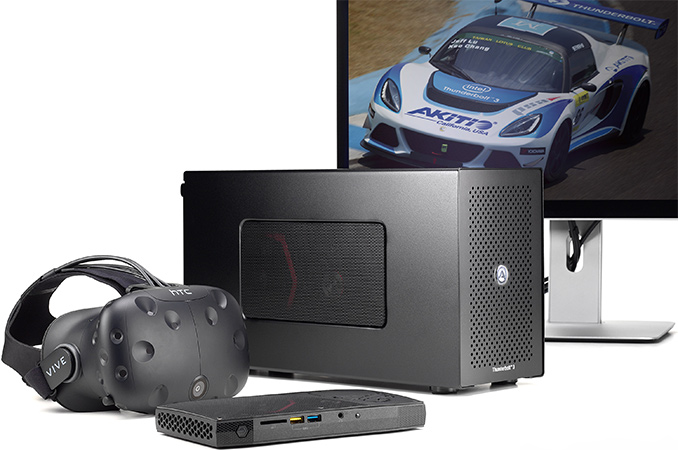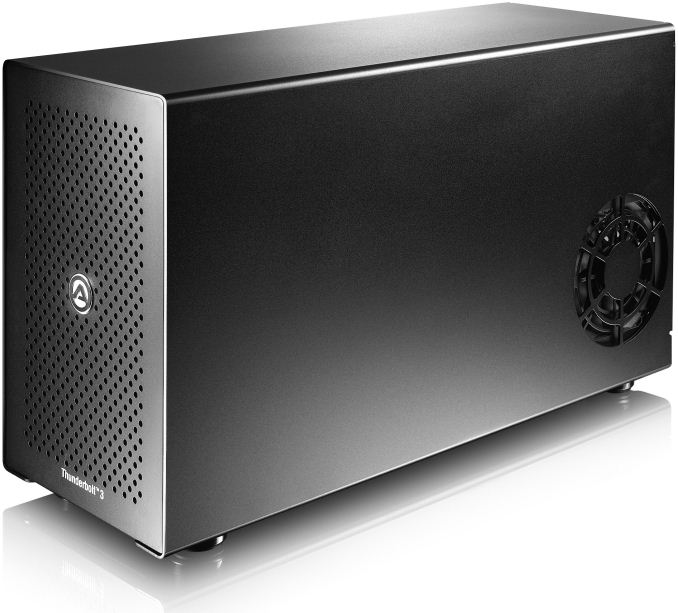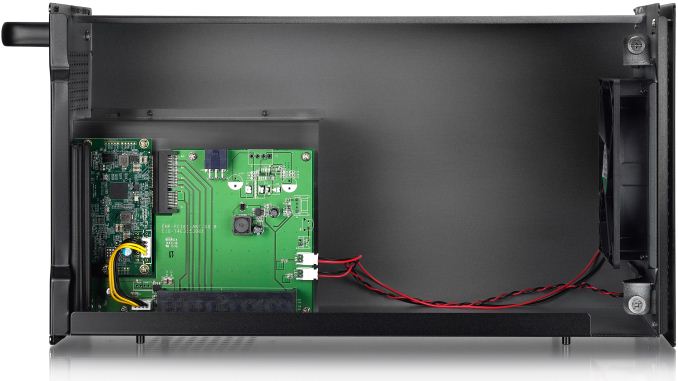AKiTiO Introduces Node: Thunderbolt 3 eGFX Box for $299
by Anton Shilov on November 14, 2016 4:50 PM EST- Posted in
- GPUs
- External GPU
- Thunderbolt 3
- eGFX
- Akitio
- Node

Over the past week AKiTiO has formally introduced its new external graphics enclosure using a Thunderbolt 3 connection. As with other external graphics enclosures, the AKiTiO Node allows a user to easily upgrade the graphics sub-system of notebook, AIO or SFF PCs that have a Thunderbolt 3 port by using a discrete graphics card. One of the key elements to eGFX is price and look, and AKiTiO has placed the Node at $299, but itcan fit graphics cards with massive coolers.
Enthusiasts started to experiment with external graphics over Thunderbolt 2 interface several years ago after multiple attempts of companies like ATI/AMD, ASUS and some others to develop commercial external GPU technologies had failed. Back in 2014, plugging a video card to a MacBook Pro using Thunderbolt 2 was costly: users had to buy a chassis for up to $1000 (there were cheaper methods, but they did not look solid), a PSU and a graphics board. The homebrew method worked, but had a number of limitations when it came to bandwidth, hot-plugging (more importantly, unplugging), driver support and some others, not to mention the aesthetics of such eGFX setups. Given the trend towards miniaturization of mobile and desktop PCs, the idea of external graphics was far too alluring to skip, which is why Intel decided to support it with its Thunderbolt 3 technology introduced in 2014. While technically TB3 is PCIe 3.0 x4 over a cable, to properly enable operation of external GPUs, Intel and its allies had to ensure support of eGFX hardware though operating systems, GPU drivers, firmware and so on. Earlier this year all pieces of the puzzle finally came together and the first “official” TB3 eGFX chassis were introduced by Razer and PowerColor.
While both Razer Core and PowerColor Devil Box do the job and even feature a couple of extras, they are rather expensive as they add more than just GPU features - $499 and $379, respectively. This week, AKiTiO, which has been offering external Thunderbolt enclosures for years, introduced its eGFX box that costs $299.99.
| AKiTiO Node (NODE-T3IA-AKTU) eGFX Chassis Specifications | ||||
| Max Video Card Size | Double-Wide, 12.2" Long (312 × 170 × 44 mm) |
|||
| Max Video Card Power | 300 W (?) | |||
| Connectivity | 1 × Thunderbolt 3 (>40 Gbps via active cable) | |||
| Chassis Size | 5.71 × 16.85 × 8.94 inches (145 × 428 × 227 mm) |
|||
| Internal PSU | 400 W SFX | |||
| System Requirements | Thunderbolt 3 eGFX Certified PC Thunderbolt 3 w/Active Cable (included) Windows 10 |
|||
| Shipping Date | December 2016 | |||
| Price | $299 | |||
The AKiTiO Node is a 42.8 × 14.5 × 22.7 cm (16.85 × 5.71 × 8.94 inches) box made of stainless steel that is compatible with a variety of double-wide full-length/full-height AMD and NVIDIA graphics cards (see the list here). The Node comes with an integrated 400 W SFX PSU (which means that it can be upgraded) as well as one 120 mm fan. As for dimensions, the Node seems to be a little more spacious inside than its rivals, which is good for cooling and compatibility with custom video cards (such as those from ASUS or EVGA). Despite this, GPUs with hybrid cooling (integrated liquid cooling) are not supported, such as AMD Radeon R9 Fury X.
| Comparison of Thunderbolt 3 eGFX Chassis | |||||||
| AKiTiO Node |
BizonTech BizonBox 3 |
PowerColor Devil Box |
Razer Core |
||||
| Chassis Dimensions | Length | 42.8 cm 16.85 in |
36 cm 14.17 in |
40 cm 15.748 in |
34 cm 13.38 in |
||
| Height | 22.7 cm 8.94 in |
20.5 cm 8.07 in |
24.2 cm 9.52 in |
21.84 cm 8.6 in |
|||
| Width | 14.5 cm 5.71 in |
8 cm 3.5 in |
17.2 cm 6.77 in |
10.5 cm 4.13 in |
|||
| Max Dimension of Compatible Graphics Card | Length | 31.2 cm 12.2 in |
|||||
| Height (PCB+Cables) |
17 cm 6.7 in |
over 14" over 5.51" |
14 cm 5.51 in |
15.2 cm 5.98 in |
|||
| Width | 4.4 cm 1.73 in |
5 1.96 in |
4.4 cm 1.73 in |
||||
| Maximum GPU Power | 300 W (?) | 375 W | |||||
| PSU | Wattage | 400 W | 200W/400W | 500 W | |||
| Form-Factor | SFX | external | internal proprietary | ||||
| Cooling Fans | 1 × 120 mm | 2 × 60 mm | unknown | 3 × 80 mm | |||
| Connectivity | Thunderbolt | 1 × TB3 | 2 × TB3 | 1 × TB3 | |||
| Ethernet | 1 × GbE | ||||||
| USB | - | 4 × USB 3.0 | |||||
| SATA | - | 1×SATA 6Gb/s | - | ||||
| DisplayPort | - | 1 × DP 1.2 | - | ||||
| Availability | December 2016 | October 2016 | April 2016 | ||||
| Price | $299 | $649 | $379 | $499 | |||
Unlike competing products, the AKiTiO Node is a pure external GPU box and nothing more. It does not have extra USB 3.0 ports (to connect a VR headset, for example), a GbE controller nor a SATA connector. This naturally cuts down its costs and allows Akito to sell the eGFX enclosure at $299 price-point, but additional USB ports will be greatly missed by owners of ultra-thin laptops as well as SFF PCs.
AKiTiO plans to start selling the Node (NODE-T3IA-AKTU) in December.
Source: AKiTiO


















56 Comments
View All Comments
abrowne1993 - Monday, November 14, 2016 - link
Glad to see more of these but they're still too expensive for me.sorten - Monday, November 14, 2016 - link
Good to see more competition in the eGPU market. If the SP5 doesn't have a TB3 connector I'll be switching to a Dell XPS or something similar.DanaGoyette - Monday, November 14, 2016 - link
This is yet another device that lacks the daisy-chaining ability. Why do companies leave that out?DanNeely - Monday, November 14, 2016 - link
Because a GPU really does need more or less the full x4 bandwidth to avoid bottlenecking in a significant fraction of games.Dropping to an PCIe 3.0 x2 equivalent (brown bars in the linked article) has a 8-9% average penalty vs x16 at 1080p. While that doesn't sound bad the average is a mix of games which are virtually un-impacted and others that get badly clobbered. COD4 was the worst with a 33% penalty, but there were several others that took hits of nearly 20%.
https://www.techpowerup.com/reviews/AMD/R9_Fury_X_...
PS I wouldn't hold my breath for the situation improving significantly with TB4/PCIe4 in a few more years. The relative scaling from reduced lanes has held more or less constant since the first tests like this where done about a decade ago with PCIe 1.0 cards.
PPS if these manage to catch on enough that volume does start pushing down prices I suspect we probably will start seeing docking station/pass through models showing up a bit more widely as a way to differentiate in the market, but for gaming purposes I don't think the TB pass through will ever be a good idea. USB's another story since it's bandwidth normally only needs a tiny fraction of TBs bandwidth and smart drivers/controllers should be able to interleave its' packets into gaps in the PCIe traffic.
Lolimaster - Monday, November 14, 2016 - link
With this huge things is just cheaper and more convenient to build yourself a miniITX pc and a cheapo laptop.beginner99 - Tuesday, November 15, 2016 - link
Yeah that's always my conclusion. The tech is great and cool but in real live not practical or cost efficient. If you go the light laptop + extensions route you need the laptop, the eGPU dock, the eGPU and also another laptop dock in this case (for Mouse, keyboard, network, USB...).The docks make this a bad deal full of compromise.I rather pay maybe a little more for a nice desktop and an even smaller (albeit less powerful) laptop.
In reality I haven't used my laptop in weeks. For coaching surfing smartphone is good enough mostly and for everything else I use my desktop. So you can just as well put most of the money in a desktop and the rest in a better smartphone or a tablet.
xype - Tuesday, November 15, 2016 - link
I get a fairly good laptop at work (new 2016 MBP) which has amazeballs in CPU and SSD speeds for its form factor. Getting a ~$500-700 eGPU setup at home would give me the performance of a $1500+ standalone gaming system. For me it’s a really interesting options, once I know how well it works.It’s probably similar for most other people who _need_ a decent laptop for work.
Compared to a dedicated gaming ITX it’s not cheap, of course. But that’s not their market. In fact, I’d guess people looking for "cheap" are as far removed from their market as it gets.
negusp - Tuesday, November 15, 2016 - link
There isn't Mac eGPU support, and there may never be.xype - Tuesday, November 15, 2016 - link
Yeah, Google tells me something different. https://www.google.com/search?client=safari&rl...Beatnutz_ - Tuesday, November 15, 2016 - link
Depends on what you want to use it for. We're using a product like this for 3D renders. Even people with laptops can connect to them easily and boost render time by quite a lot. It's expensive, but very flexible. For gaming you are better off building a proper PC'N yes.